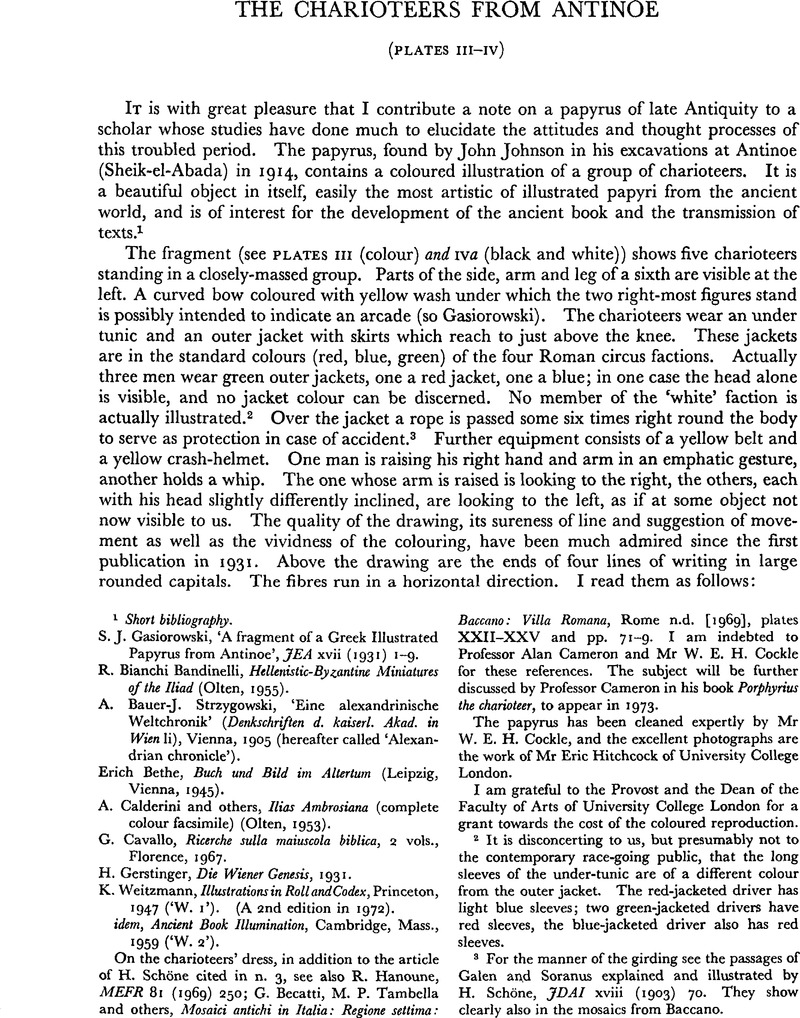Article contents
The Charioteers from Antinoe
Published online by Cambridge University Press: 11 June 2012
Abstract

- Type
- Research Article
- Information
- Copyright
- Copyright © The Society for the Promotion of Hellenic Studies 1973
References
1 Short bibliography.
Gasiorowski, S. J., ‘A fragment of a Greek Illustrated Papyrus from Antinoe’, JEA xvii (1931) 1–9Google Scholar.
Bandinelli, R. Bianchi, Hellenistic-Byzantine Miniatures of the Iliad (Olten, 1955)Google Scholar.
Strzygowski, A. Bauer-J., ‘Eine alexandrinische Weltchronik’ (Denkschriften d. kaiserl. Akad. in Wien li), Vienna, 1905 (hereafter called ‘Alexandrian chronicle’)Google Scholar.
Bethe, Erich, Buch und Bild im Altertum (Leipzig, Vienna, 1945)Google Scholar.
Calderini, A. and others, Ilias Ambrosiana (complete colour facsimile) (Olten, 1953)Google Scholar.
Cavallo, G., Ricerche sulla maiuscola biblica, 2 vols. Florence, 1967Google Scholar.
Gerstinger, H., Die Wiener Genesis, 1931Google Scholar.
Weitzmann, K., Illustrations in Roll and Codex, Princeton 1947 (‘W. 1’). (A 2nd edition in 1972)Google Scholar.
Weitzmann, K., Ancient Book Illumination, Cambridge, Mass., 1959 (‘W. 2’)CrossRefGoogle Scholar.
On the charioteers' dress, in addition to the article of H. Schöne cited in n. 3, see also R. Hanoune, MEFR 81 (1969) 250; Becatti, G., Tambella, M. P. and others, Mosaici antichi in Italia: Regione settima: Baccano: Villa Romana, Rome n.d. [1969], plates XXII–XXV and pp. 71–9Google Scholar. I am indebted to Professor Alan Cameron and Mr W. E. H. Cockle for these references. The subject will be further discussed by Professor Cameron in his book Porphyrius the charioteer, to appear in 1973.
The papyrus has been cleaned expertly by Mr W. E. H. Cockle, and the excellent photographs are the work of Mr Eric Hitchcock of University College London.
I am grateful to the Provost and the Dean of the Faculty of Arts of University College London for a grant towards the cost of the coloured reproduction.
2 It is disconcerting to us, but presumably not to the contemporary race-going public, that the long sleeves of the under-tunic are of a different colour from the outer jacket. The red-jacketed driver has light blue sleeves; two green-jacketed drivers have red sleeves, the blue-jacketed driver also has red sleeves.
3 For the manner of the girding see the passages of Galen and Soranus explained and illustrated by H. Schöne, JDAI xviii (1903) 70. They show clearly also in the mosaics from Baccano.
4 W. 1, p. 53.
5 See Plate IVb.
6 Turner, E. G., Greek Manuscripts of the Ancient World, no. 47.Google Scholar
7 See Plate IVc taken from New Pal. Soc. I 151.
8 Gasiorowski p. 9, first half of the fifth century A.D. Bianchi Bandinelli, Rendiconti Accad. Lincei vi (1951) 430 and Hellenistic-Byzantine Miniatures of the Iliad 25 n. 6 and 110 n. 2 gives the date as ‘4th cent.’ without discussion.
9 6 ἢλα[ suggests ἢλα[ϲε, ἣλατο as well as a variety of articulations with η λα[. 7 μω[ is more difficult. Neither μώνυχεϲ ἳπποι nor μῶλον ʾ Αρῆοϲ occur at this sedes. 8 πω[ suggests, e.g. πῶ[λοι, 11 προ[ e.g. προ[φρονέωϲ.
10 Similarly I cannot place verse 6 ff. in the Anthology from the index of the first verses of epigrams in the Didot edition or in that of Beckby. Mr W. E. H. Cockle tells me he has not found a corresponding series of line-beginnings in Nonnus. These searches have been made by hand and eye. The negative result is confirmed by a search of the computer tapes of the whole of Iliad and Odyssey, of Hesiod and of Apollonius Rhodius conducted by means of a programme devised by the Rev. A. Q. Morton and run at the Computing Centre of the University of Edinburgh.
11 Pindar, Pyth. v 45 ff. (this reference I owe to Professor P. Corbett) must mean a field of 41 charioteers at Delphi, in the race won by Alexibiades. In the pretended race in Soph. El. 700 there were ten starters.
- 5
- Cited by


